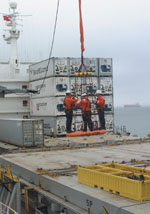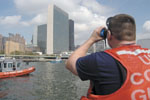Vital Data Stem Maritime Threats
 |
| U.S. Coast Guardsmen enter port at sunset to tie up after a patrol aboard a cutter. The service is at the center of maritime domain awareness programs to globally track vessels, cargos and crews headed toward entry in U.S. ports. Container cargos often enter West Coast ports for shipment to the East Coast, where they are again loaded on ships bound for Europe. China’s largest trading partner is the European Union. |
Consistently locating and tracking the world’s commercial vessels, their cargos and crews is like hoisting a halyard with a large holiday ensign during a nor’easter—tricky but not impossible. More than 80,000 commercial ships from more than 100 nations ply the seas at any given moment, making maritime domain awareness critical for the nation’s protection.
Indeed, this stark reality resulted in a recent presidential directive that is gaining traction by integrating and aligning all federal agency maritime security programs and initiatives. This Maritime Domain Awareness, or MDA, program encompasses comprehensive integration of federal, state, local and private sectors. A new national maritime strategy is being developed that builds on current activities and exploits existing strategies, tools and resources, according to Rear Adm. Joseph L. Nimmich, USCG. He is the director of the MDA program integration office.
Uniquely positioned as both a military and law enforcement service, the U.S. Coast Guard can bridge the gap between the U.S. Department of Homeland Security (DHS), first responders and the U.S. Navy, with its forward-deployed assets operating in open ocean reaches.
The admiral notes that the Coast Guard is working closely with the U.S. Defense Department and other agencies in implementing the President’s plan to achieve MDA and to employ specific Coast Guard-related projects. This awareness includes the effective knowledge of all activities and elements transiting the ocean or
MDA is a tall order when
Moreover, greater involvement of the entire maritime community is necessary to increase security and to protect the maritime transportation system. In May 2004, senior federal department leaders provided a road map pointing toward an effective national MDA capability. The agencies included the departments of Defense, Homeland Security, Transportation, Commerce and Energy as well as other involved organizations. A senior steering group was formed, which defined for the White House a possible MDA presidential decision, the admiral reveals. As a result, National Security Presidential Directive 41, the national maritime security strategy, emerged from the White House with eight subordinate area plans, Adm. Nimmich observes. Among them was domain awareness implementation.
The
“A maritime domain implementation team is responsible for developing an interagency concept of operations and an interagency investment plan,” the admiral notes. The Coast Guard decided this is a critical area of participation in a leadership role, since MDA is the basis for all of the missions and responsibilities of this organization. “With better MDA, our effectiveness will increase in all of our required missions, including both security and non-security-related activities.” As a result, the Coast Guard created the staff the admiral heads. A 27-year veteran, he is a graduate of the Coast Guard Academy and has commanded the cutters Point Estero, Red Beech and Sorrel. He also holds a master’s degree in business administration.
 |
| Members of a Coast Guard vessel boarding team are lifted in a personnel transport device, called a Billy Pugh, onto the deck of a commercial container vessel. Shipping containers suspected of carrying contraband such as explosives or weapons of mass destruction are removed in remote port areas. The Coast Guard inspects commercial containers looking for hotboxes with contraband. |
The closer shipping comes to the
The AIS information also is very valuable within a security context. A system now captures this information, which is required under International Maritime Organization (IMO) guidance. The IMO is a United Nations-sponsored organization. Ships transiting with 300 gross tons or greater must have an AIS capability. If not, they are denied entry in
The information vessels provide is correlated and validated from other sources to determine accuracy. An anomaly occurs when that information does not jibe, which generates research and identification to determine whether there is a problem. Often, it is simply a case where information inadvertently or inaccurately entered the system, such as an error on the vessel’s name or number, the admiral says. “Sometimes this situation is easily rectified; however, it provides an opportunity to note anomalies and have better awareness.”
Another program, called Command 2010, puts in place a series of sensors and a command and control architecture in
Persistent MDA requires a common operating picture (COP) blended with a common intelligence picture (CIP). The COP provides situational awareness—the movement of ships within a specific area. The ability to display this information from a number of data sources such as AIS, radar and commercial satellite images makes it common. The CIP adds a layer of information as large numbers of ships move through the nation’s waters at any given time, both offshore and inland.
Another major program involves long-range tracking to capture both voluntary and involuntary shipping at much greater distances than with the AIS. “We are working very closely with IMO and international partners to establish regulatory requirements that will provide necessary information,” Adm. Nimmich asserts. He remarks that a strong cultural bias exists; mariners have had more than 3,000 years of unregulated freedom of movement at sea. Oceangoing passage is unlike the airlines, which evolved in a regulated industry where flight plans and position location transmissions are required for safety. The Coast Guard also faces another challenge in providing a framework that will enable identification of recreational boats.
The Maritime Transportation Security Act requires the Coast Guard to develop implementation of an AIS-like system that reports the location and identity of vessels in real time. This system will enhance the Coast Guard’s capabilities to target and track vessels and will promote the safe navigation of ships approaching or exiting a port.
The admiral is working with other agencies to align the new programs as part of the MDA plan, the operational concept and the investment strategy to avoid duplication in spending, technologies and personnel. The information from these programs can be shared across agencies. “NORTHCOM [U.S. Northern Command], as an example, may need the information for a different purpose or for a similar need. The trick is to make sure we are all aligned and collaborating wherever we have requirements while also involving partners at state and local levels as well as at the Defense Department and other federal agencies.”
Adm. Nimmich adds that a group of agencies concerned with MDA are exploring modeling and simulation techniques at Lockheed Martin’s Center for Innovation, or the Lighthouse (see page 47), to harness expertise and technology for possible MDA applications. The company’s joint venture Integrated Coast Guard Systems work and the Coast Guard’s Deepwater Systems program help establish a foundation for MDA.
Shawn D. James, Lockheed Martin’s vice president of maritime security and domain awareness, stresses that the company is taking its lead from the top-level guiding principles of the Bush administration published in the national strategy. He functions within the corporation’s Maritime Systems and Sensors business unit. There are few details within the national strategy but a lot of activity within the DHS, Coast Guard and Customs and Border Protection as they seek answers to wide-ranging MDA questions.
“One of the things we are trying to do is assist a myriad of customers with a better understanding of their problems. Millions of containers are being shipped and are at sea with their associated crews. There appears to be a lot of information available on these vessels and their cargos,” James discloses. A U.S. Naval Academy graduate, he earned a master’s degree in information technology management and served on active duty as director of intelligence for the Naval Special Warfare Development Group. His business experience includes the Aegis combat weapons system and the Coast Guard’s Deepwater Systems program.
Lockheed Martin uses the term integrated domain awareness (IDA) rather than MDA because the complexity of domain awareness requires multiple integrated solutions. James heads the IDA effort across the corporation. IDA solutions require multiple technical, operational and policy actions. “This is a fertile ground for industry opportunity as well as for government. We are helping the customer think through the problems by providing context. The company started its IDA effort last summer and has assembled a top-notch pool of talent to allow rapid development of a national concept of operations and an investment plan with great fidelity,” he states.
Trade-offs and costs associated with various solutions, whether organizational or technical, will be made available to the customer, James emphasizes. Late last year, the Lighthouse hosted a workshop with NORTHCOM, Coast Guard, Navy and Customs and Border Protection personnel to validate a tool the company developed and to clarify customer assumptions that lead to analyses. With its modeling and simulation technical advances, the center is positioned to provide clarity with the tool. This capability can iterate results and extend them across different agencies to synthetically explore various concepts of operation, policy structure and technologies. “They do not have to be, nor would I expect them to be, Lockheed Martin technologies,” James says.
 |
| A Coast Guard boarding team member, Petty Officer 2nd Class Dann L. Merrick, from Maritime Safety and Security Team 91101 scans the water near the United Nations Building in Manhattan with another armed patrol boat nearby. As many as 150 international heads of state attend General Assembly meetings in the building. |
A key to success, James believes, is to determine whether MDA will be better tomorrow than it is today. “And what are those measures of effectiveness? Balancing the risks associated with cargo containers entering West Coast ports for transshipment across the country is an area being delved into as part of our analyses. This will require tracking cargo—not a trivial task when up to 30 percent of all containers entering
An aspect of risk management involves the Customs-Trade Partnership Against Terrorism, or C-TPAT, a joint government-business initiative to build cooperative relationships that strengthen overall supply chain and border security. C-TPAT recognizes that customs can provide the highest level of security only through close cooperation with the ultimate owners of the supply chain—importers, carriers, brokers, warehouse operators and manufacturers.
“One concept is to develop a government risk assessment model that looks at the supply chain for weaknesses. A part of this involves the inspection regime and the mechanisms by which agencies cooperate to share information,” James confirms. Unfortunately, most of the information involving cargos and shipping manifests is in communications stovepipes and not shared across agencies. Despite the dynamics of the problem, he maintains, Lockheed Martin is well positioned for system analysis thinking, to take a holistic look at the problems being tackled and break down the barriers. Innovation that exists within the Lighthouse serves as a magnet, especially after earlier IDA studies determined that a concept of operations is the top priority and can make the biggest impact in an effective MDA.




Comments